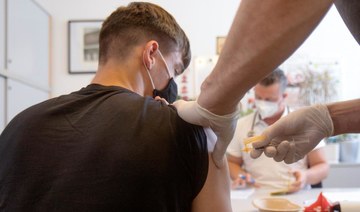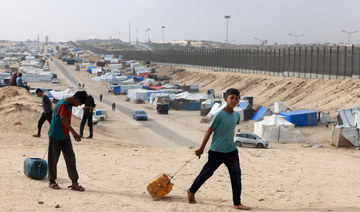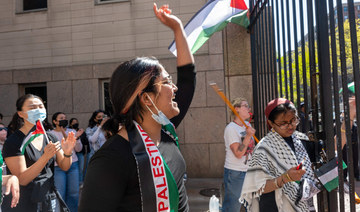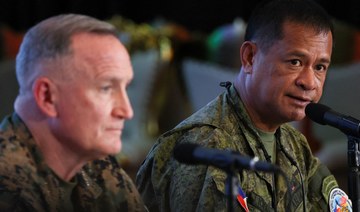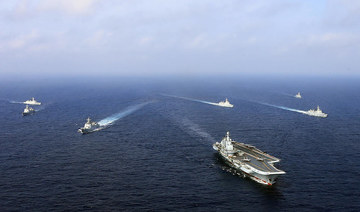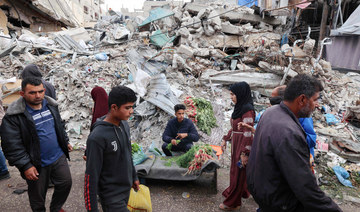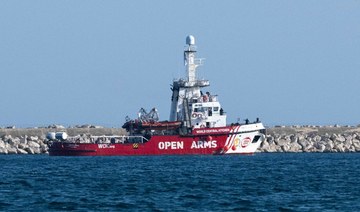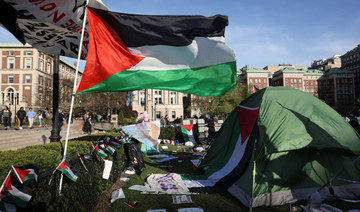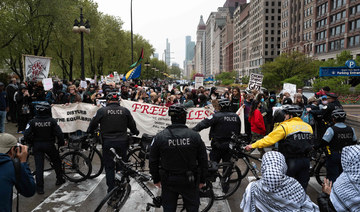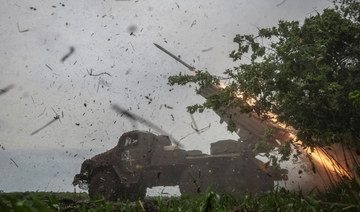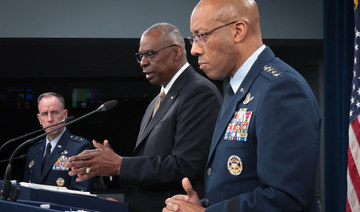NEW YORK: Two years into the COVID-19 pandemic, most of the world has seen a dramatic improvement in infections, hospitalizations and death rates in recent weeks, signaling the crisis appears to be winding down. But how will it end? Past epidemics may provide clues.
The ends of epidemics are not as thoroughly researched as their beginnings. But there are recurring themes that could offer lessons for the months ahead, said Erica Charters of the University of Oxford, who studies the issue.
“One thing we have learned is it’s a long, drawn-out process” that includes different types of endings that may not all occur at the same time, she said. That includes a “medical end,” when disease recedes, the “political end,” when government prevention measures cease, and the “social end,” when people move on.
The COVID-19 global pandemic has waxed and waned differently in different parts of the world. But in the United States, at least, there is reason to believe the end is near.
About 65 percent of Americans are fully vaccinated, and about 29 percent are both vaccinated and boosted. Cases have been falling for nearly two months, with the US daily average dropping about 40 percent in the last week alone. Hospitalizations also have plummeted, down nearly 30 percent. Mask mandates are vanishing — even federal health officials have stopped wearing them — and President Joe Biden has said it’s time for people to return to offices and many aspects of pre-pandemic life.
But this pandemic has been full of surprises, lasting more than two years and causing nearly 1 million deaths in the US and more than 6 million around the world. Its severity has been surprising, in part because many people drew the wrong lesson from a 2009-2010 flu pandemic that turned out to be nowhere as deadly as initially feared.
“We got all worried but then nothing happened (in 2009), and I think that was what the expectation was” when COVID-19 first emerged, said Kristin Heitman, a Maryland-based researcher who collaborated with Charters.
That said, some experts offered takeaways from past epidemics that may inform how the end of the COVID-19 pandemic may play out.
FLU
Before COVID-19, influenza was considered the most deadly pandemic agent. A 1918-1919 flu pandemic killed 50 million people around the world, including 675,000 in the US, historians estimate. Another flu pandemic in 1957-1958 killed an estimated 116,000 Americans, and another in 1968 killed 100,000 more.
A new flu in 2009 caused another pandemic, but one that turned out not to be particularly dangerous to the elderly — the group that tends to die the most from flu and its complications. Ultimately, fewer than 13,000 US deaths were attributed to that pandemic.
The World Health Organization in August 2010 declared the flu had moved into a post-pandemic period, with cases and outbreaks moving into customary seasonal patterns.
In each case, the pandemics waned as time passed and the general population built immunity. They became the seasonal flu of subsequent years. That kind of pattern is probably what will happen with the coronavirus, too, experts say.
“It becomes normal,” said Matthew Ferrari, director of Penn State’s Center for Infectious Disease Dynamics. “There’s a regular, undulating pattern when there’s a time of year when there’s more cases, a time of year when there’s less cases. Something that’s going to look a lot like seasonal flu or the common cold.”
HIV
In 1981, US health officials reported a cluster of cases of cancerous lesions and pneumonia in previously healthy gay men in California and New York. More and more cases began to appear, and by the next year officials were calling the disease AIDS, for acquired immune deficiency syndrome.
Researchers later determined it was caused by HIV — human immunodeficiency virus — which weakens a person’s immune system by destroying cells that fight disease and infection. For years, AIDS was considered a terrifying death sentence, and in 1994 it became the leading cause of death for Americans ages 25 to 44.
But treatments that became available in the 1990s turned it into a manageable chronic condition for most Americans.
ZIKA
In 2015, Brazil suffered an outbreak of infections from Zika virus, spread by mosquitoes that tended to cause only mild illness in most adults and children. But it became a terror as it emerged that infection during pregnancy could cause a birth defect that affected brain development, causing babies to be born with unusually small heads.
By late that year, mosquitoes were spreading it in other Latin American countries, too. In 2016, the WHO declared it an international public health emergency, and a US impact became clear.
“It just sort of burned out” and the pressure for making a Zika vaccine available in the US ebbed, said Dr. Denise Jamieson, a former CDC official who was a key leader in the agency’s responses to Zika.
COVID-19
The Geneva-based WHO declared COVID-19 a pandemic on March 11, 2020, and it will decide when enough countries have seen a sufficient decline in cases — or, at least, in hospitalizations and deaths — to say the international health emergency is over.
The WHO has not yet announced target thresholds. But officials this week responded to questions about the possible end of the pandemic by noting how much more needs to be accomplished before the world can turn the page.
COVID-19 cases are waning in the US, and dropped globally in the last week by 5 percent. But cases are rising in some places, including the United Kingdom, New Zealand and Hong Kong.
People in many countries need vaccines and medications, said Dr. Carissa Etienne, director of the Pan American Health Organization, which is part of the WHO.
In Latin America and the Caribbean alone, more than 248 million people have not yet had their first dose of COVID-19 vaccine, Etienne said during a press briefing with reporters. Countries with low vaccination rates likely will see future increases in illnesses, hospitalizations and deaths, she said.
“We are not yet out of this pandemic,” said Dr. Ciro Ugarte, PAHO’s director of health emergencies. “We still need to approach this pandemic with a lot of caution.”
How will COVID-19 end? Experts look to past epidemics for clues
https://arab.news/5rj9j
How will COVID-19 end? Experts look to past epidemics for clues

- The ends of epidemics are not as thoroughly researched as their beginnings
- The COVID-19 global pandemic has waxed and waned differently in different parts of the world
Pro-Palestinian protests keep roiling US college campuses
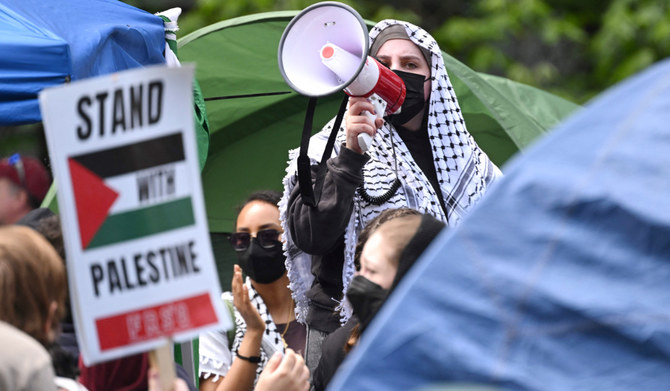
- Israel has killed more than 34,000 Palestinians, according to Gaza’s Health Ministry
- “They were expecting about 65,000 people on campus, and they just did not feel that it was going to be safe,” Bass said on CNN’s “State of the Union”
WASHINGTON: Pro-Palestinian protests at US universities showed no sign of slowing as they spread coast-to-coast over the weekend and police crackdowns and arrests continued into another week while students vowed to stay in tent encampments until their demands are met.
The students’ demands range from a ceasefire in Israel’s war with Hamas to calls for universities to stop investing in Israeli enterprises involved with the country’s military to an end for US military assistance for Israel.
Pro-Palestinian protests have spread to college campuses across the US, stoked by the mass arrest of over 100 people on Columbia University’s campus more than a week ago.
The Columbia campus was peaceful on Saturday and there were no reports of arrests of disturbances overnight, a school spokesman told Reuters.
But crackdowns continued at a handful of campuses on Saturday including a lockdown at the University of Southern California (USC) and a heavy police presence. More than 200 people were arrested at a handful of schools including 80 late on Saturday at Washington University in St. Louis. Among those arrested at Washington University was 2024 Green Party presidential candidate Jill Stein.
“They are sending in the riot police and basically creating a riot in an otherwise peaceful demonstration. So this is just shameful,” Stein said in a statement.
Washington University said in a statement that those arrested would be charged with trespassing.
On Sunday, dueling demonstrations were set to begin at the University of Southern California, Los Angeles. Outside groups were planning to demonstrate in favor of and against the pro-Palestinian encampments.
Members of the Harriet Tubman Center for Social Justice planned to support students’ right to protest.
In opposition, however, a group called Stand With Us will hold a “Stand in Support of Jewish Students” rally to “stand up against hatred and antisemitism.”
The nationwide protests have caught the attention of President Joe Biden.
White House national security spokesman John Kirby told ABC News on Sunday that the president knows there are very strong feelings about the war in Gaza.
“He understands that, he respects that and as he has said many times, we certainly respect the right of peaceful protest,” Kirby said. “People should have the ability to air their views and to share their perspectives publicly, but it has to be peaceful.”
Kirby added that the president condemns antisemitism and condemns hate speech.
At USC, leadership has canceled the main commencement ceremony after it called off the valedictorian speech by a Muslim student who said she was silenced by anti-Palestinian hatred.
Los Angeles Mayor Karen Bass said on Sunday she believed that canceling the commencement was a decision “they had to make.”
“They were expecting about 65,000 people on campus, and they just did not feel that it was going to be safe,” Bass said on CNN’s “State of the Union.”
China confronts Japanese politicians in disputed East China Sea area
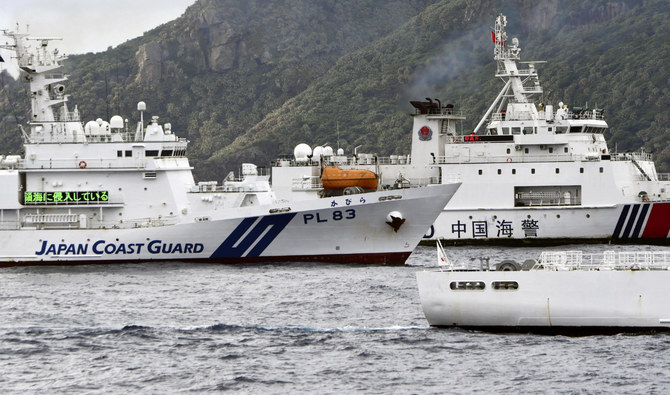
BEIJING/TOKYO: China’s coast guard confronted Japanese lawmakers in waters claimed by both countries in the East China Sea, China’s embassy in Tokyo and Japanese media said on Sunday, the latest in a series of maritime disputes involving China and its neighbors.
Chinese vessels took unspecified law enforcement measures, the embassy said in a statement, adding that it had lodged solemn representations for what it called “infringement and provocation” by Japan near tiny, uninhabited islands that Beijing calls the Diaoyu and Tokyo calls the Senkaku.
The Japanese group, including former Defense Minister Tomomi Inada, was on an inspection mission organized by the city of Ishigaki in Okinawa prefecture, according to the Chinese Embassy and Japanese public broadcaster NHK.
Japan and China have repeatedly faced off around the Japan-administered islands. China also has escalating run-ins with the Philippine navy in disputed areas of the South China Sea, where Beijing’s expansive maritime claims conflict with those of a number of Southeast Asia nations.
Inada’s group spent three hours near the islands on Saturday, using drones to observe the area, and the Japanese coast guard vessel sought to fend off the Chinese coast guard, NHK said.
“The government and the public are aware of the severe security situation,” said Inada, a senior official of the ruling Liberal Democratic Party, according to NHK. “The Senkaku are our sovereign territory and we need to go ashore for research.”
It was the first such inspection trip to the area involving a member of Japan’s parliament since 2013, NHK reported.
Officials of Japan’s foreign ministry were not immediately available for comment outside of working hours.
China strongly urged Japan to abide by what it called a consensus reached between the two countries, stop political provocations, on-site incidents and hyping up public opinion, the embassy said.
It asked Japan to “return to the right track of properly managing contradictions and differences through dialogue and consultation, so as to avoid further escalation of the situation.”
World Central Kitchen to resume Gaza aid after staff deaths in Israeli strike
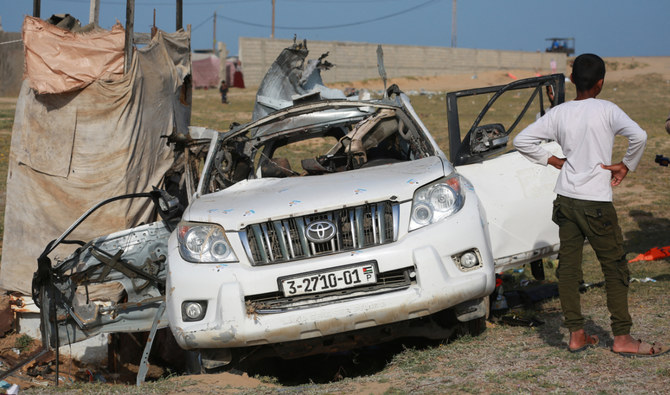
NICOSIA: World Central Kitchen or WCK said it would resume operations in the Gaza Strip on Monday, a month after seven workers of the US-based charity were killed in an Israeli air strike. Prior to halting operations, WCK had distributed more than 43 million meals in Gaza since October, representing by its own accounts 62 percent of all international NGO aid.
The charity said it had 276 trucks with the equivalent of almost 8 million meals ready to enter through the Rafah Crossing and will also send trucks into Gaza from Jordan.
“The humanitarian situation in Gaza remains dire,” said the charity’s chief executive officer Erin Gore.
“We are restarting our operation with the same energy, dignity, and focus on feeding as many people as possible.”
The April 1 deaths triggered widespread condemnation and demands from Israel’s allies, including the US, for an explanation.
Israel said its inquiries had found serious errors and breaches of procedure by its military, dismissing two senior officers and reprimanding senior commanders.
WCK is demanding an independent investigation. Israel’s six-month war against Hamas in Gaza followed an Oct. 7 attack by the militant group in southern Israel when more than 250 hostages were seized and some 1,200 people killed, according to Israeli tallies. Israel’s offensive has killed more than 34,000 people, Palestinian health authorities say, and caused a humanitarian disaster for the enclave’s more than 2 million inhabitants.
“We have been forced to make a decision: Stop feeding altogether during one of the worst hunger crises ever ... Or keep feeding knowing that aid, aid workers and civilians are being intimidated and killed,” Gore said.
“These are the hardest conversations, and we have considered all perspectives when deliberating. Ultimately, we decided we must keep feeding, continuing our mission of showing up to provide food to people during the toughest of times.” (Writing by Michele Kambas; Editing by Andrew Cawthorne)
White House urges ‘peaceful’ campus protests after hundreds arrested
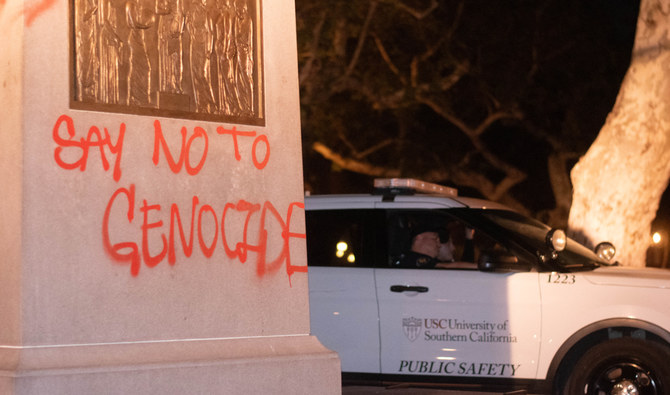
WASHINGTON: The White House insisted on Sunday that pro-Palestinian protests that have rocked US universities in recent weeks must remain peaceful, after police arrested around 275 people on four separate campuses over the weekend.
“We certainly respect the right of peaceful protests,” National Security Council spokesman John Kirby told ABC’s “This Week.”
But, he added: “We condemn the anti-Semitism language that we’ve heard of late and certainly condemn all the hate speech and the threats of violence out there.”
The demonstrations began at Columbia University in New York, but they have since spread rapidly across the country.
While peace has prevailed on many campuses, the number of protesters detained — at times by police in riot gear using chemical irritants and tasers — is rising fast.
They include 100 at Northeastern University in Boston, 80 at Washington University in St. Louis, 72 at Arizona State University, and 23 at Indiana University.
Among those arrested at Washington University was Green Party presidential candidate Jill Stein, who faulted police for aggressive tactics she said provoked the sort of trouble they are meant to quell.
“This is about freedom of speech ... on a very critical issue,” she told CNN shortly before her arrest on Saturday.
“And there they are, sending in the police and creating a riot.”
College administrators have struggled to find the best response, caught between the need to respect free-speech rights and the imperative of containing inflammatory and sometimes violently anti-Semitic calls by protesters.
At the University o Southern California, school officials late on Saturday closed the main campus to the public after pro-Palestinian groups again set up an encampment that had been cleared earlier, the school announced on X.
With final exams coming in the next few weeks, some campuses — including the Humboldt campus of California State Polytechnic University, have closed and instructed students to complete their classes online.
The activists behind the campus protests — not all of them students — are calling for a ceasefire in Israel’s war with Hamas and want colleges to sever ties with Israel.
Ukraine warns front ‘worsened’ as Russia claims fresh gains
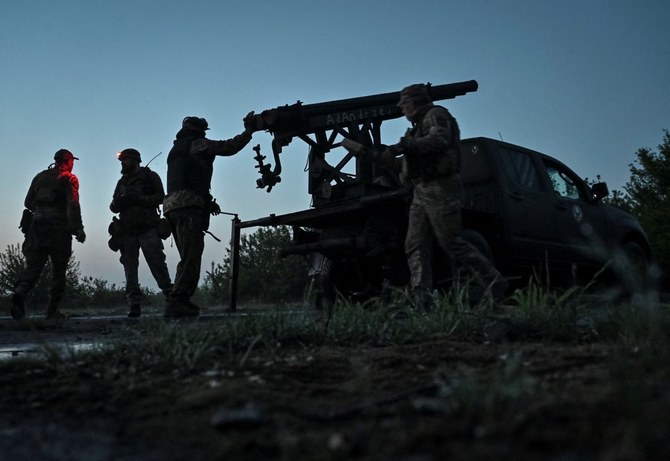
- Russia’s troops are advancing in the eastern Donetsk region
- The US finally approved a $61 billion package of financial aid
VOZDVYZHENKA, Ukraine, April 28, 2024 Agence France Presse: Ukraine’s army leader admitted Sunday that Kyiv’s position on the battlefield has worsened after Russian forces captured another village in the east, pressing their advantage in manpower and ammunition.
Russia’s troops are advancing in the eastern Donetsk region as Kyiv awaits the arrival of much-needed US weapons that it hopes will stabilize the fragile front lines.
“The situation at the front has worsened,” Ukrainian commander-in-chief Oleksandr Syrsky said in a Facebook post Sunday.
Ukrainian troops had “retreated” westwards to new defensive lines in a section of the front that runs past the city of Donetsk, controlled by pro-Russian forces since 2014.
Russia has “a significant advantage in forces and means” and had been able to notch up advances amid “heavy fighting,” Syrsky said.
“In some sectors the enemy had tactical success, and in some areas our troops managed to improve the tactical position,” he added.
Russia’s defense ministry earlier on Sunday claimed its troops had captured the village of Novobakhmutivka in the Donetsk region — around 10 kilometers (six miles) north of Avdiivka, which they seized in February.
The stark assessment of the picture facing Ukrainian troops comes at the end of week of ups and downs for Kyiv.
The United States finally approved a $61 billion package of financial aid after months of political wrangling, unlocking much-needed arms for Ukraine’s stretched troops.
But on the battlefield Russia chalked up more successes.
Its troops managed to make rapid advances in a narrow column to the northwest of Avdiivka.
In the village of Vozdvyzhenka, some eight kilometers from the fighting in Ocheretyne, AFP reporters saw civilians loading a small truck with furniture and belongings on Sunday.
“We’re going a long way from here... I don’t have time to talk because of the shelling,” one of them told AFP, before climbing into the vehicle and speeding out of the village.
Soldiers on the side of a road in the woods said they had originally been sent to build defensive lines.
“But the situation has changed. We were told not to take the shovels but to stay and wait for orders. The Russians are attacking and advancing,” one told AFP, speaking on condition of anonymity.
Syrsky confirmed on Sunday that Russia had made some “tactical” progress in that part of the front, but said Moscow had not yet achieved what he called an “operational advantage.”
He also said additional units were being deployed to replace those that had sustained heavy losses.
The recent setbacks have prompted rare criticism from Ukraine’s military bloggers.
“The (Russian) breakthrough near Ocheretyne revealed a number of problems,” the Deep State Telegram channel, with close links to the Ukrainian army, said in a post on Wednesday.
It said leaders of the 115th mechanized brigade, which is fighting in the area, were “responsible for the collapse of the defense in the entire sector, allowing significant losses.”
Kyiv’s forces are outnumbered across the battlefield, with the country struggling to recruit enough soldiers to replace those who have been killed, wounded or exhausted by the war, now in its third year.
Leaders in Kyiv have warned the military outlook could worsen in the next few weeks, while shipments of US weapons are making their way to the front lines.
“We are still waiting for the supplies promised to Ukraine,” said President Volodymyr Zelensky in his evening address Sunday.
Speaking after talks with Hakeem Jeffries, leader of the Democrats in the US House of Representatives, he said he had once again stressed the urgent need for Patriot anti-missile systems “as soon as possible.”
Ukraine’s head of intelligence at the ministry of defense Kyrylo Budanov said this month that the battlefield situation would likely be at its most difficult in mid-May to early June.




